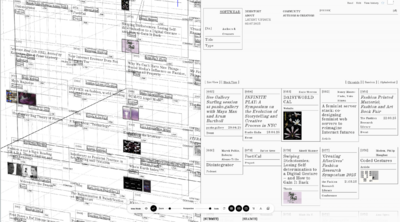Infrastructure
From softwear.directory
Jump to navigation
Jump to search
⤢ a directory that gathers, stacks and links practices that work with, through and beyond (digital) fashion […]
LATEST UPDATE 26.09.2025
[082]
A feminist server stack: co-designing feminist web servers to reimagine Internet futures
critical
This paper explores the idea of a "feminist server stack," which challenges traditional, centralized internet infrastructure by proposing alternative, community-driven digital spaces. It draws from feminist principles to rethink how digital tools and networks are designed, governed, and used—prioritizing care, consent, and collective control over data. The paper critiques dominant, profit-driven tech ecosystems and imagines new ways of structuring servers, storage, and communication that align with ethical and inclusive values. Ultimately, it advocates for a reimagined digital landscape where technology empowers marginalized voices and fosters more equitable, decentralized, and self-sustaining digital communities.
In reimagining servers as sites of care, A Feminist Server Stack enacts affirmative ethics by centering consent, maintenance, and relationality within digital infrastructure. Through co-design, it resists extractive norms and proposes a situated, collective stack that foregrounds the politics of hosting—where serving becomes an act of feminist world-building.
29.12.25
[090]
Vanish Pointer
Individual
experimental

Vanish Pointer by Hyunseo Cho (as used on the Softwear Directory)
Vanish Pointer is a web-based project by Hyunseo Cho that reimagines the digital interface as a three-dimensional, perspective-based space. Designed as both a web extension and a standalone platform, this tool establishes an analogy between our perception of web interfaces and the visual system of perspective. Users can shift the vanishing point to explore websites from new angles, transforming flat webpages into dynamic spatial environments where citational elements — such as sources, authors, dates and internal references — become central structuring forces. Users can invert hierarchies, reveal hidden relationships, and explore multidimensional connections by changing their viewpoint — including curvilinear, panoramic, and spherical perspectives. Vanish Pointer thus encourages critical and sensory engagement with the knowledge architectures that shape online content.
In an age where information circulates endlessly, is remixed and is decontextualised, developing visual citation methods is not just a matter of giving credit; it is an urgent way of taking relational accountability. The hypertextual nature of our digital environments is full of hidden lineages: sources, references and contextual cues that are often obscured by flat, linear design conventions. Experimental approaches such as Vanish Pointer reclaim these overlooked dimensions, rendering citation as a spatial, visual and navigable architecture, not just metadata. By reimagining interfaces as relational terrains, such tools encourage users to think critically about how knowledge is structured, traced and performed, transforming acts of reading, browsing and linking into moments of situated awareness.
In doing so, they foreground citational relationality — an understanding of citation as an active, situated practice that reveals the networks of dependency, influence and care underpinning digital knowledge, rather than as a static reference.
29.12.25
[SUBMIT]
As the online realm often feels infinite, this directory highlights non-commercial, critical, and experimental online content related (but not limited) to fashion and creative practices. It features projects, essays, visuals, and events, offering tools to navigate this dynamic landscape.
In gathering a wide variety of practitioners and collectives, we are always expanding, and looking to add to this growing bibliography of ‘being online’.
If you've encountered or created something that fits within this scope, feel free to share and submit!
Retrieved from "https://softwear.directory/index.php?title=Infrastructure&oldid=3732"